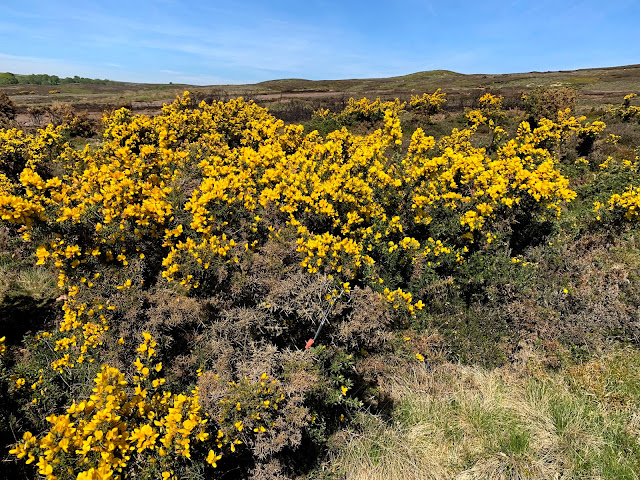The emperor moth (Saturnia pavonia) is one of our most spectacular day-flying moths but although it is fairly widespread it is not often seen. There have been only four records in the vice county of South Northumberland (VC67) on iRecord in the last five years and three of those were caterpillars. Male emperor moths can be attracted to a pheromone lure impregnated into a small rubber bung. It must not be handled or touched on any vegetation so as not to leave a trace which might distract male moths. It also shouldn't be used for more than 30 minutes and shouldn't be left unattended. Having read all the instructions and having consulted the Northumberland Moths website to find the history of local records I decide to try when I went up to Simonside to look for bilberry bumblebees a few weeks ago. I hung the lure on a willow branch using a surgical clip and was astonished to see a moth appear within four minutes. It flew around madly within a radius of about 30m but I never got close to taking a photo. After five minutes or so it realised the whole thing was a scam and flew away. Ten minutes later it (or another one) returned and the whole episode was repeated. Still no photo but it was promising start.
I have been wanting try in the south of the county but throughout most of May the weather was cold and wet. Finally it improved last weekend so I went to Muggleswick with friends Denise & Phil to look for the moth, amongst other things. As we started looking for green hairstreak butterflies I hung out the lure.
This time it took only a couple of minutes before a moth appeared. Again it was very active but I managed a few blurry pictures which at least confirm the ID.
Emperor moths fly in April and May so we were already right at the end of the flight period - although it may be delayed this year by the cold spring. So two days later I decided to have one last attempt and returned to Muggleswick. This time I set a stopwatch and it took 90s for the moth to appear from what looks a superficially unpromising habitat - just burnt heather and scrubby gorse.
This short video shows how the moth flies and illustrates the challenge for photography.
The moth stayed around for 10 minutes and occasionally paused for a fraction of a second, just long enough for a photo. This one and the photo at the top of this post were the best of them.
A few of the other photos show the moth's extraordinary antennae with which it can detect the faintest whiff of pheromone. The last two are very heavily cropped.
The female is larger than the male and flies at night so is much harder to see in the wild. She has similar markings to the male but is grey/blue. You can see beautiful photos of the female on the Butterfly Conservation website. My pheromone lure is back in the freezer but I shall be trying it out at a few other locations next year.











Stunning moth with the most amazing antennae. The males must have thought their luck was in with a female flying in daylight. Poor things. Seems odd they have evolved to be active at different times of the day, but it obviously works for them.
ReplyDelete